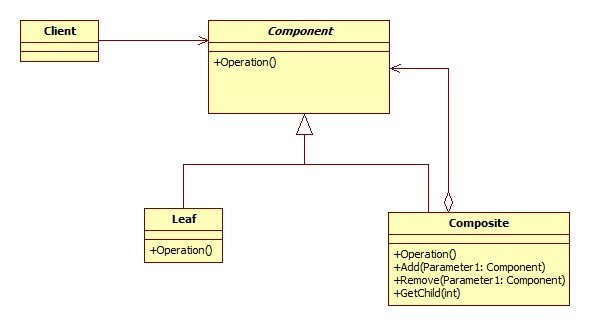Java 中组合模型之对象结构模式的详解
一、意图
将对象组合成树形结构以表示”部分-整体”的层次结构。Composite使得用户对单个对象和组合对象的使用具有一致性。
二、适用性
你想表示对象的部分-整体层次结构
你希望用户忽略组合对象与单个对象的不同,用户将统一使用组合结构中的所有对象。
三、结构

四、代码
public abstract class Component {
protected String name; //节点名
public Component(String name){
this.name = name;
}
public abstract void doSomething();
}
public class Composite extends Component {
/**
* 存储节点的容器
*/
private List components = new ArrayList<>();
public Composite(String name) {
super(name);
}
@Override
public void doSomething() {
System.out.println(name);
if(null!=components){
for(Component c: components){
c.doSomething();
}
}
}
public void addChild(Component child){
components.add(child);
}
public void removeChild(Component child){
components.remove(child);
}
public Component getChildren(int index){
return components.get(index);
}
}
public class Leaf extends Component {
public Leaf(String name) {
super(name);
}
@Override
public void doSomething() {
System.out.println(name);
}
}
public class Client {
public static void main(String[] args){
// 构造一个根节点
Composite root = new Composite("Root");
// 构造两个枝干节点
Composite branch1 = new Composite("Branch1");
Composite branch2 = new Composite("Branch2");
// 构造两个叶子节点
Leaf leaf1 = new Leaf("Leaf1");
Leaf leaf2 = new Leaf("Leaf2");
branch1.addChild(leaf1);
branch2.addChild(leaf2);
root.addChild(branch1);
root.addChild(branch2);
root.doSomething();
}
}
输出结果:
Root
Branch1
Leaf1
Branch2
Leaf2
如有疑问请留言或者到本站社区交流讨论,感谢阅读,希望能帮助到大家,谢谢大家对本站的支持!
:简化模板代码)
只要做懂这3道题肯定能脱离菜鸟称号!)
:heroes案例 效果演示)


:过渡---文档分析)




:钩子函数--文档分析)


:钩子函数--代码演示(面试重点))


:钩子函数--代码演示(面试重点)二)

面试题5:从尾到头打印链表)
:项目1---项目功能展示)